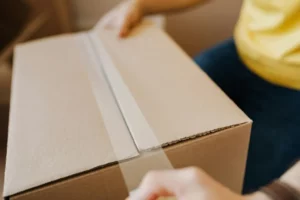If you’ve ever considered using a shipping container for storage, you’re not alone. Many suburban homeowners are turning to shipping containers as a cost-effective and durable solution for extra storage space. Whether you’re storing furniture during a home renovation, keeping seasonal equipment safe, or just looking for a long-term storage solution, knowing how to properly load and unload your container is essential. Here are a few shipping container storage tips for homeowners and business owners alike!
Preparing for the Shipping Container Process
Choosing the Right Location

Before you even think about loading your container, make sure you have the right spot for it.
- Find a Level Surface: A shipping container needs to sit on a stable and level surface to prevent shifting or tilting over time. Concrete, gravel, or a compacted dirt pad are good options.
- Consider Drainage: Avoid placing your container in a low-lying area where water could collect. A slightly elevated spot will help prevent moisture buildup inside.
- Check Local Regulations: Some suburban neighborhoods have restrictions on shipping containers. Before you bring one onto your property, check zoning laws and HOA guidelines.
Gathering Necessary Equipment

Loading and unloading heavy or bulky items requires the right tools. Here’s what you should have on hand (also offered by RAC)
- Dollies and Hand Trucks: Essential for moving large items like furniture and appliances.
- Ramps: If your container is elevated, a sturdy ramp will make loading and unloading much easier.
- Ratchet Straps and Tie-Downs: Keep your items from shifting inside the container.
- Protective Gear: Gloves, steel-toe boots, and back support belts can help prevent injuries.
Loading Tips for Maximum Storage Efficiency
Plan Your Layout Before You Start

The key to an easy-to-access container is good organization. Think of your container as a puzzle—placing items in the right order will make a huge difference.
- Load Heavy Items First: Start with the largest and heaviest items, like furniture and appliances. Position them along the back and sides of the container to create a stable base.
- Stack Vertically but Safely: Use sturdy boxes and pallets to stack items up to maximize space. Be sure to leave space for air circulation.
- Keep Frequently Needed Items Near the Door: If you’ll need access to certain items before others, keep them towards the front of the container for easy retrieval.
- Use Shelving and Pallets: If you plan to store items long-term, adding shelves or using pallets to keep things off the ground can help prevent moisture damage.
Securing Items to Prevent Shifting during and after loading
A shipping container can experience temperature changes and slight movement due to ground settling, which can cause stacked items to shift. Secure your belongings properly using these shipping container storage tips when loading and unloading:
- Use Ratchet Straps: Tie down heavy items to prevent movement.
- Fill Empty Spaces: Use blankets, foam, or other padding to fill in gaps between items and minimize shifting.
- Wrap Fragile Items: Use bubble wrap, furniture pads, or blankets to protect delicate items.
Unloading Tips to Ensure Safety

Check for Any Shifted Items Before Opening
If your container has been sitting for a while, there’s a chance that items may have shifted. Before opening the doors, tap on them gently to check for pressure buildup or anything pressing against them. Open the doors slowly to prevent anything from falling out unexpectedly.
Unload in a Controlled Manner
- Remove Straps and Bracing First: Start by taking off any ratchet straps or tie-downs before moving large items.
- Work from Front to Back: Take out items in reverse order of how they were loaded, working from front to back to avoid creating unstable stacks.
- Use a Dolly or Hand Truck for Heavy Items: This will save your back and prevent potential injuries.
- Get Help if Needed: Some items may be too heavy to handle alone. Having a friend or family member assist can make the process smoother and safer.
Special Tips for Long-Term Storage

Weather-Proofing and Moisture Control
If you’re planning to store items for an extended period, moisture and temperature fluctuations can be a concern. Here’s how to protect your belongings:
- Use Moisture Absorbers: Placing silica gel packs or moisture absorbers inside the container can help prevent mold and mildew.
- Ensure Proper Ventilation: Shipping containers can get hot in the summer and cold in the winter. Adding vents or using a dehumidifier can help regulate moisture levels.
- Cover Items with Tarps or Plastic Wrap: This adds an extra layer of protection against dust and moisture.
Common Mistakes to Avoid
 Even with the best planning, there are a few pitfalls to watch out for:
Even with the best planning, there are a few pitfalls to watch out for:
- Overloading the Container: Keep weight evenly distributed and don’t exceed the container’s weight capacity.
- Ignoring Safety Gear: Always use gloves, proper footwear, and lifting techniques to prevent injury.
- Stacking Items Too High Without Support: Tall stacks can collapse, causing damage or injury. Use shelving or stabilizers.
- Forgetting to Label Boxes: Clearly mark boxes so you can find what you need quickly later on.
- Not Checking Local Regulations: If your neighborhood has restrictions on shipping containers, you don’t want to find out after it’s already delivered!
Conclusion
Using a shipping container for storage can be a fantastic solution for suburban homeowners, offering ample space and security for your belongings. By following these shipping container storage tips, you can ensure your items stay safe, organized, and easily accessible when you need them.
A little planning goes a long way—take the time to set up your container properly, and you’ll thank yourself later. Have you used a shipping container for storage before? I’d love to hear your experience and any additional tips you might have!
Looking for the right container option? Click here to check out Rent-A-Container.
